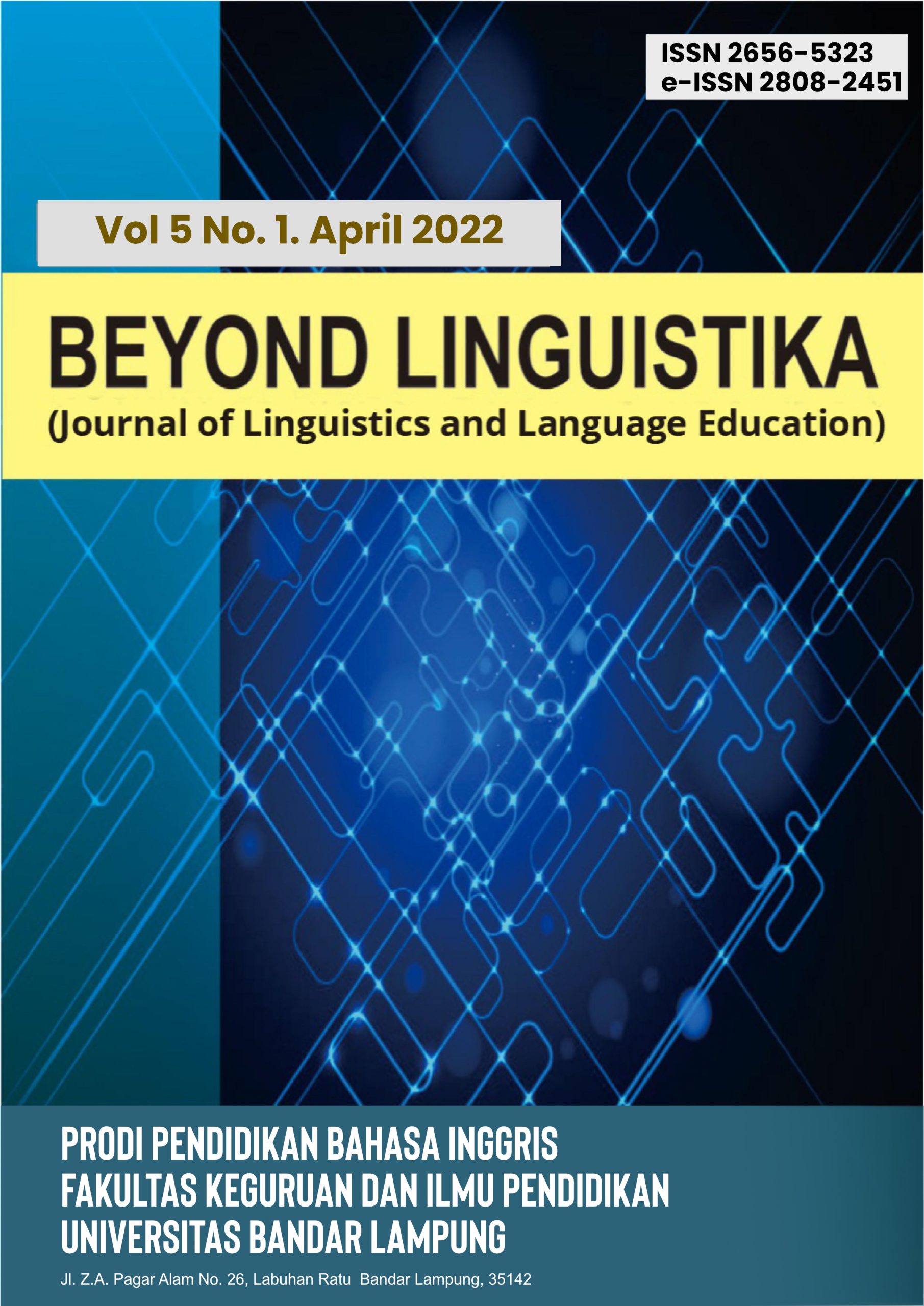STUDENTS’ PERCEPTIONS IN USING NARROW READING AND NARROW LISTENING IN SPEAKING CLASS AT THIRD SEMESTER OF ENGLISH DEPARTMENT UNIVERSITAS BANDAR LAMPUNG
Abstract
This research describes the student’s perceptions in using narrow reading and narrow listening in speaking class at third semester of English Department Universitas Bandar Lampung. It is to find out the student’s perception about narrow reading and narrow listening whether those methods are effective or not to be used in speaking class, and whether those methods could help them in improving their speaking ability or not. The population of this research were the third semester students of English Department Universitas Bandar Lampung. The sample of this research was taken by using purposive sampling method. The instruments used for collecting the data were observation, questionnaire, and interview. The data analysis of this research was qualitative. The result of this research show that the students were very interested in learning and they gave a positive attitude and good response when those methods were implemented in their classes. From the questionnaire and the interview result, it shows that mostly they said that those methods can help them to speak as well as to understand what they should say when they should tell their topic in front of the class. Based on the research, it was found that the use of narrow reading and narrow listening in speaking class was effective and it was very useful and help the students in improving their speaking skill as well as help the students in achieving their goal in learning speaking skill. Therefore, it was suggested to use narrow reading and narrow as a media in teaching English generally and teaching speaking skill particularly.
Keywords
Full Text:
PDFReferences
REFERENCES
Ahmad, K., Seken, L.P., and Artini. (2013). A study on strategies for teaching speaking and reading comprehension skills. E-journal Program Pascasarjana Universitas Pendidikan Ganesha, Vol. 1.
Akhyak & Indramawan, A. (2013). Improving the Students’ English Speaking Competence through Storytelling (Study in Pangeran Diponegoro Islamic College (STAI) of Nganjuk, East Java, Indonesia). International Journal of Language and Literature, Vol. 1 No. 2.
Arung, F. (2016). Improving the Students’ speaking skill through debate technique. Journal of English Education, 1(April), 70-76. Retrieved from https://doi.org/10.1016/j.ecol eng.2009.03.005.
Braun, V. & Clarke. (2006). Using thematic analysis in psychology. Qualitative research in psychology. Bristol, 3(2), 77-101.
Broughton, G., Brumfit, C., Flavell, R., Hill, P., & Pincas, A. (1980). Teaching English as a foreign language. New York, NY: Routledge.
Cashin, W. E., & Downey, R. G. (1992). Using global student rating items for summative evaluation. Journal of Educational Psychology, 84(4), 563–572. https://doi.org/10.1037/0022-0663.84.4.563
Centra, J. A., & Gaubatz, N. B. (2005). Student Perceptions of Learning and Instructional Effectiveness in College Courses.
Dharmawan, Yanuarius Yanu., Saniyati, M. (2016). Improving Students’ Pronunciation by Using Audio-Visual-Assisted Text. Proceedings, 75-80.
Dinata, H., & Anggraini, R.W. (2017). The Use of Gallery Walks to Enhance the Speaking Achievement of The Ninth-Grade Students of SMP PGRI 1 Palembang. Jurnal Bahasa dan Sastra, 6(1), 50-56.
Hadriana. (2008). Improving students' speaking skill through communicative activities in small group discussion at the third semester class A of the English study program of FKIP UNRI. Journal of English and Education, 2(2), 34-51.
Hamalik, Oemar. (2001). Proses Belajar Mengajar. Jakarta : Bumi Aksara. _________, 2008. Metode Diskusi.
Harnad, S. (Ed.). (1987). Categorical perception: The groundwork of cognition. Cambridge University Press.
Hornby, A.S., (1987). Oxford Advance Learner’s Dictionary of current English. Oxford: Oxford University Press.
Klimova, B. F. (2014). Detecting the development of language skills in current English language teaching in the Czech Republic. Procedia - Social and Behavioral Sciences, 158, 85–92.
Krashen, S.D. (1981) Second Language Acquisition and Second Language Learning. Pergamon Press Inc., Oxford.
Krashen, S (1996), The case for narrow listening. System, 24(1), 97-100.
Krashen, S. (2004). The case for narrow reading. Language Magazine, 3(5), 17-19.
Mardianti, R.C. (2018). Students’ perceptions of using animation video in teaching listening of narrative text (a case study at the tenth-grade students of Madrasah Aliyah Negeri 4 Jakarta).
Miarso, Yusuf Hadi. (2004). Menyemai Benih Teknologi Pendidikan. Jakarta: Prenada Media.
Mujiningsih, E. S. (2009). Improving Students’ Speaking Ability Through Project Work (A classroom action research at SMK Negeri 2 Surakarta)
Mulyasa. 2012. Praktek Penelitian Tindakan Kelas. 2012. Bandung: PT Remaja Rosdakarya
Neuman, W.L. (2014). Social Research Methods: Qualitative and Quantitative Approaches. Harlow UK: Pearson Education.
Nunan, D. (1998). Research Methods in Language Learning (7th ed.). Cambridge: Cambridge University Press.
Nursanti, Y. (2016). Students’ perceptions of teacher’s bilingual language. Journal of English and Education, 4(1), 159–176.
Pramestiya, A. (2013). Students’ Perceptions on the Use of PowerPoint in Public Speaking Classes.
Rohmawati, A. (2015). Efektivitas Pembelajaran. Jurnal Pendidikan Usia Dini, 9(1).
Ryan, J., & Harrison, P. (1995). The relationship between individual instructional characteristics and the overall assessment of teaching effectiveness across different instructional contexts. Research in Higher Education, 36(5), 577-594.
Sukandi, S. S., Sumatra, W., & Barat, S. (2015). English Composition within Multi linguistic Challenges in Minangkabau- Indonesian EFL Students’ Writing Behaviors, 24–32.
Walgito, Bimo (2001) Psikologi Sosial, Yogyakarta: Andi Offset.
Zuhriyah, M. (2017). Storytelling to improve students’ speaking skill. English Education: Jurnal Tadris Bahasa
DOI: http://dx.doi.org/10.36448/bl.v2i1.2336
Refbacks
- There are currently no refbacks.















